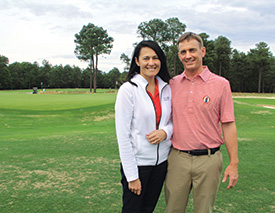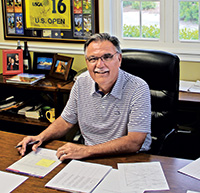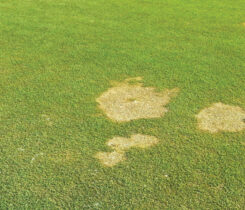Pinehurst No. 2 in good hands as it hosts back-to-back U.S. Opens
Pinehurst No. 2 will be the focus of the golf world as it hosts back-to-back U.S. Opens. Led by Kevin Robinson, golf history couldn’t be in better hands.
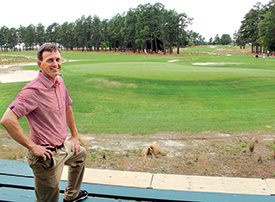 PINEHURST, N.C. — Right here on No. 18, at about this time, in only 44 days, a champion will be crowned.
PINEHURST, N.C. — Right here on No. 18, at about this time, in only 44 days, a champion will be crowned.
Right here on No. 18, at about this time, in only 51 days, another champion will be crowned.
And right here, on No. 18, at about this time, Kevin Robinson, CGCS, superintendent of Pinehurst’s famed No. 2 course, will have made golf history by having successfully played host to the USGA’s U.S. Open and U.S. Women’s Open in back-to-back weeks.
Yes, it will be hard work… but the reward will be a memory for a lifetime.
The renovation
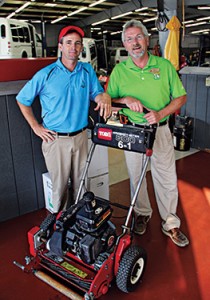 Before even considering the logistics of hosting the U.S. Open (June 12-15) immediately followed by the U.S. Women’s Open (June 19-22), consider what this course has gone through in the past five years.
Before even considering the logistics of hosting the U.S. Open (June 12-15) immediately followed by the U.S. Women’s Open (June 19-22), consider what this course has gone through in the past five years.
The No. 2 that hosted the 2005 U.S. Open and the No. 2 of 2014 barely resemble each other. If it were a high school reunion, No. 2 is that friend who lost so much weight he is only recognizable by the sound of his voice. But instead of pounds, No. 2 dropped bermudagrass rough. Lots.
The renovation by Bill Coore and Ben Crenshaw, now widely celebrated, was a culture shock at first. The idea was to take away all the bermudagrass roughs and bring back the sweeping white sand and a selection of native vegetation that was present when Donald Ross designed the course in 1907. Fairways went from an average width of 27 yards to an average width of 46 yards. The course went from 1,150 irrigation heads to 450 irrigation heads, from using 55 million gallons of water annually to 12 million gallons.
“What Donald Ross had here is one of the best natural landscapes for golf in America. That landscape included sand hills and wiregrass,” says Bob Farren, CGCS, director of maintenance at Pinehurst Resort. “Coore and Crenshaw knew that was the identity of the course. And frankly, we had covered a lot of it up in my 31 years here.”
The practice of overseeding was also eliminated. That means diesel rough mowers now get parked in November and don’t get fired up again until the spring, saving on gas. It also saves on water, fertility and labor.
The process of bringing in native vegetation — some of which other courses might call weeds — was keyed in on with the help of the turf program at N.C. State University. Tom Rufty, Ph.D., and Danesha Seth Carley, Ph.D., helped Pinehurst identify what plants would thrive and be favorable, and what plants would be invasive.
Now vegetation with common names like horseweed, carpetweed and crowfoot grass are prevalent throughout the course.
“We’re redefining what people call weeds. It’s only a weed if you don’t want it there,” says Seth Carley. “Bob and Kevin would take us around the course and point something out. They’d say, ‘We love this. How do we get more of it and spread it?’”
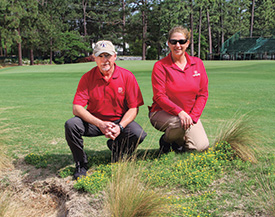
Tom Rufty, Ph.D., N.C. State University (left) & Danesha Seth Carley, Ph.D., N.C. State University (right)
The crew planted 20,000 Carolina wiregrass sprigs by hand.
“Think about planting all this wiregrass and not knowing if it would live or not,” laughs Robinson. “When we first started I thought, ‘Golly, is this stuff going to make it?’ I would have been happy with a 60 percent success rate. But shoot, every one of them made it.”
John Jeffreys, assistant superintendent on No. 2 says that though this new look is more sustainable, it’s not necessarily easier to maintain.
“It takes skilled labor to manage the wire grass areas,” Jeffreys says. “Anyone can hop on a rough mower and mow rough — just don’t put it in a bunker. But to tell someone to selectively remove these plants, those plants, but not these plants? It’s a difficult method. We manage this course completely different now. There was rough, pine straw, clear wooded areas, no pine cones. It’s almost like going to two different properties… even on different sides of the country.”
Architect Bill Coore realizes the change he put the crew through at Pinehurst No. 2. The renovation wouldn’t have succeeded, he says, without their complete buy-in.
“When you change one of America’s finest courses like this, you have to have everyone believe in it. It’s a total team effort,” Coore told Golfdom. “Change is not the easiest thing. I can say that, being a former superintendent. Ben (Crenshaw), Toby (Cobb) and I are so thankful that these guys helped us in every way to succeed. Because this is the exact opposite of what they were doing.”
But one thing has not changed about this challenging Ross course: the difficulty of the greens and the greens surrounds. What may look like a well-hit shot into any green may end up meandering off the back side, into a bunker, or to a significant elevation drop.
“The greens and the greens surrounds, no matter what we have — 4-inch bermudagrass rough or wiregrass out there, nothing has changed about the greens, nothing has changed about the greens surrounds,” Robinson says. “The greens, they are the defender of par out here.”
Location, location, location
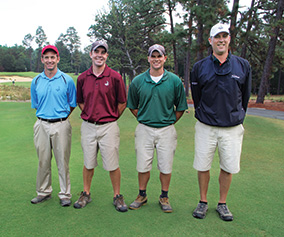
Robinson with (L to R) assistant superintendent Alan Owen, spray tech Curt Proctor and assistant superintendent John Jeffreys.
This crazy idea to host back-to-back Opens… Pinehurst is the perfect location to try it. They have the manpower, the equipment, the space, all right here. Need to lengthen the tee shot on No. 12? Borrow some land off of adjoining course four. Need a 39,000 square foot merchandise pavilion? No. 18 fairway on course one will serve nicely.
And the crew? All of the superintendents at Pinehurst are ready to jump in as the Opens near. Superintendents Kyle Brown (No. 1, No. 3, No. 5); Steve Wilson (No. 4 and No. 7) and Jeff Hill (No. 6 and No. 8) and their respective crews will make for one of the most experienced tournament crews ever. After all, they all already know the details of working at Pinehurst Resort.
“The people I work with are the biggest assets we have,” Robinson says. “My assistants would already be superintendents somewhere if it wasn’t for the Open. And all the levels we have out here, from the superintendents to the part-timers… we’re very lucky.”
“For our sake, it’s caused us to look back and consider that we’re doing two weeks of this,” Farren says. “Kevin and his staff, both regular and part-time, and the volunteers… without question it’s an opportunity for us and the USGA to tread new water.”
Condition: Men vs. Women
U.S. Open conditions are tough to maintain for one week, but Robinson and his crew will need to keep the course on that edge for two weeks.
“The biggest difference for the men and the women will be the firmness of the greens. Hopefully Mother Nature will cooperate,” Robinson says as he drives the back nine of No. 2. “Hopefully it won’t rain too much, we’ve been very lucky the last two Opens. But we figure for a two-week event, one of those days it’s probably going to rain.”
Robinson says if the weather is dry, they’ll water the greens and soften them up following the conclusion of the U.S. Open. Greens will be a little softer, but speeds will be relatively the same.
In an extreme measure, depending on how firm the greens get for the U.S. Open, they are considering pencil-tining the greens with a 1/8-inch solid tine. But Robinson stresses, that would only be in an extreme case.
“I don’t think the course will be beat up (for the U.S. Women’s Open),” says Robinson. “We just went through the coldest winter in the last 22 years. We’ve had green-up weather, just not grow-in weather. Heaven forbid they tried to host this tournament up in the northeast this year.”
Lucky number 7
Robinson and his team have been putting in the hours in these weeks leading up to the Opens. Luckily for him, if he wants to see his wife, Laura, she’s a short drive away, working in the clubhouse. The two met 18 years ago, when Robinson was the foreman on Course 7, and Laura was the retail manager for Course 7. Laura is now the director of retail for all of Pinehurst Resort.
The two are not only busy preparing for history-making back-to-back Opens, but also the lives of their three children: Bailey (15), Sadie Jane (13) and Grace (11). Right now, who will get Grace to soccer practice is a bigger concern than the wiregrass.
The crew here at Pinehurst relies on Robinson. His demeanor is such that he’s a boss, but also a friend. Trash talk about the last round of golf is common.
“Kevin’s a good superintendent, he knows what he is doing and it shows, because the golf course looks awesome,” says young Curt Proctor, spray tech. “And he also treats everyone good. He’s a good friend.”
“Any time you talk to Kevin, if you’re standing there for more than three minutes, he’ll eventually pull out his pocket knife and start pulling weeds,” laughs Farren. “He’s just that obsessed, that focused. That is what we had to have on No. 2.”
“I learned from my parents that hard work pays off… that you’re recognized for putting your nose to the grindstone,” Robinson says over a cold beer at the Hickory Tavern. “I’m very proud that I got my degree in agronomy from N.C.S.U., and I started out here as a spray tech — I learned from the ground up.”
And now, he’s teaching guys like Proctor, Jeffreys and assistant superintendent Alan Owen how a former spray tech hosts back-to-back Opens.
It takes hard work.
Photos: Seth Jones






